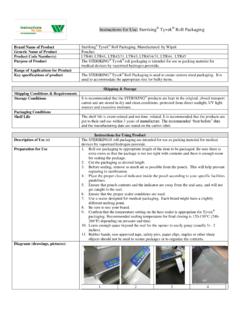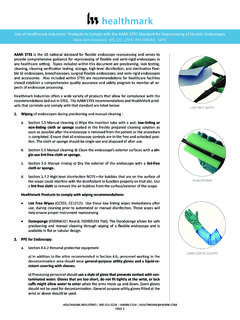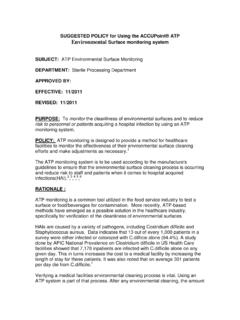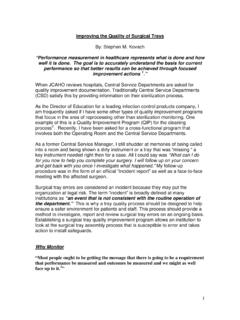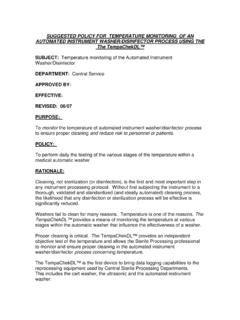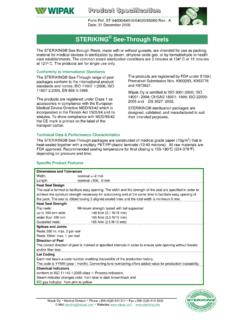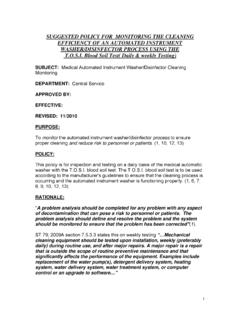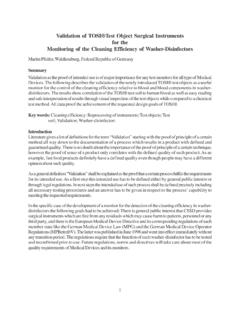Transcription of THE BASICS: Understanding the Most Common Problems …
1 1 THE basics : Understanding the most Common Problems with Tears & Wet Packs What it is: Sterilization wrap is used to maintain the sterile field in surgical packs, gowns, etc. just like peel pouches and sterile containers. It is a very flexible form of packaging because no matter the shape or size of the item the appropriate size wrap can be found. In addition if the proper wrapping technique is used they can provide a sterile field during surgery. Wrap: There are 2 main types of materials: muslin which is a reusable fabric & disposable wrappers which is a synthetic material. most hospitals use disposable wraps. When using a muslin type wrap it is important to use a light table to check for tears. Also some re-usable muslin wraps have a specific amount of usage they are approved for and they should not exceed that amount of usages.
2 Pouches: two types, paper / plastic and tyvek pouches. Problems - Tears & Moisture (Wet Packs): as with all types of packaging there are events, which can compromise the package integrity (sterile barrier). Tears: These small hole(s), cut(s) or abrasion(s) compromise the integrity of a package. Thus, when this failure is identified, the tray is no longer considered sterile and can t be used. It must be reprocessed. Common Causes: 1) Tray design a. Sharp corners b. Wire mesh tray instruments punch through c. Tray Feet d. Sterilization cart issues with sharp corners 2) Weight of set a. Orthopedic Trays b. Loaner Trays c. Over loaded with instruments d. Basic big set BOOKWALTER 3) Storage & Transportation a. Tray is heavy and/or is incorrectly removed from a shelf dragged b.
3 Burrs on wire catch tray c. Stack of trays 4) Other concerns a. Specific employees trays only having this concern of tearing b. Where the tearing happens i. After sterilization 2 ii. Tearing appears after it leaves the Central Service area iii. Find out where the tears are happening ( , trays are dragged across wire racks in case carts when being unloaded for surgery or after sterilization when the tray is pulled off the sterilization cart) Some Questions to ask on tearing: 1. What type of wrap are you using? 2. Is it a specific type of tray or service that is experiencing this concern? 3. When was the last time all staff received training on care and handling of surgical wrapped items (OR and CS staff)? 4. Where is the tearing concern being noticed?
4 A. After sterilization b. After loading into a case cart c. Upon arrival into the OR(opening of the tray) Or nurse observes tearing or pin holes Wet Packs/Moisture: Moisture in or on a tray or a peel pouched item is either a possible growth media or provides a channel for organism to travel into a sterile pack. There are 2 types of moisture: External & Internal. In either case the tray/ peel pouch and/or the load should be reprocessed. Identifying the cause for this wetness can be a very difficult process especially, if the problem occurs intermittently. Types & Causes: External Wetness (can appear on the outside a wrap item, container or a peel pouch): 1) Water droplets will be clearly visible on outside of the tray or peel pouch.
5 2) Condensate dripping from the sterilizer cart shelving or railings 3) Condensate that has collected in and is blowing through steam lines (that are improperly trapped) 4) Metal items loaded on the shelf above that may drip condensate onto items below. 5) The outline of a water droplet on the wrap/container/ peel pouch could be a sign of poor water or steam quality or even a residual from the cleaning process being exposed by the sterilization process. Internal Wetness: Always occurs at the beginning of the sterilization cycle in every set or peel pouch. However, in a good process this condensate is re-vaporized. In a bad cycle this process is impeded by one of the following: 1) Improper positioning which traps condensation and prevents re-vaporization 2) Overloading of instruments 3) Towels & Basins are prepared without absorbent materials, which are used to wick moisture for efficient drying 4) Textile packs can retain moisture when wrapped to tightly 5) Improper loading 3 6) Super Heated Steam Wet Steam: Wet steam is steam, which has high levels of small water droplets trapped within it.
6 It carries less energy than dry saturated steam and more is required to heat a given load to sterilization temperature. Wet steam causes slower heat up rates and wet loads at the end of the sterilization cycle. The steam should have a dryness value of not less than (EN 285). Causes from a sterilizer: 1. Inadequate baffling in boilers 2. Undersized boiler for the application 3. Poorly lagged steam pipe work 4. No condensate trap near sterilizer 5. Cold Chamber jacket due to fault 6. Jacket operating at reduced temperature Some Questions to ask on wet packs/pouches: 1. Do the wet packs/pouches happen at a certain time? 2. Do they happen on a certain shift? 3. Do wet packs/pouches happen at certain time of the year? Change of season?
7 4. Do wet packs/pouches happen only with certain trays? Orthopedic trays? Certain containers? Wrapped trays? 5. Is their one employee more than another that their trays have wet pack issues? 6. What is the humidity in the area where the wrapping and assembly is taking place? Is it high? 7. Have you asked your sterilizer company to check out your equipment? Has your facilities and Biomedical department been asked to look at the concern? Understanding the Issue: Identifying the specific cause for tears and/or wet packs is typically a very time consuming and frustrating process. It can get very expensive as well when the sterilizer manufacturer and/or service rep is called in. Concerning wet pack issues both AAMI and AORN offer suggestions in their recommended guidelines and standards.
8 AAMI in section talks about the use of tray liners ..the judicious use of tray liners or other absorbent material can alleviate drying material wicks 4 condensate away from instruments and disperses it over a greater surface area for more efficient 1 Section talks about loading the sterilizer and use of liners ..if a cart shelf liner is used, it should be made of a nonlinting, absorbent material that will dry in the drying time selected for the rest of the 2 It goes on to talk about the positioning of items on the sterilizer cart and how it can cause issues, .. Placing metal items above textile items should be placing metal items below textile items enables condensate to drain out without wetting other items in the talks about Paper plastic pouches.
9 Paper-plastic pouches should stand on edge in relation to the cart or shelf, with the paper side of one pouch next to the plastic side of the next pouch; holding racks or baskets specifically designed for pouches can be used. Rationale: Special racks or baskets facilitate placing paper plastic pouches on edge and properly spaced in the sterilizer for adequate sterilant contact and drying. They are also helpful in keeping similar small packages in position during the sterilization Concerning peel pouches they should be positioned usually on the top shelf and this would help prevent wetness from appearing on the pouch itself. AORN in their 2008 Preoperative Standards and Recommended Practices states ..the instrument tray or basket should be lined with an absorbent, lint-free surgical towel if indicated.
10 The towel will absorb and disperse moisture to assist in drying the set .. 3 Outpatient Surgery reported in there October 2011 Issue of that, .. damage occurred when the hospital's staff used OR towels cleaned by the linen service in sterilizing stainless steel surgical instruments and titanium implants. The towels were wrapped around the devices, which were then put through a steam autoclave. At the end of the process, the OR towels had crumbled and some of the medical instruments they were wrapped in were discolored and had to be An expert stated in court documents that ..traces of an acid that a linen service used to clean operating room towels have discolored and damaged surgical 4. The point is that surgical towels are meant for wiping hands and there intended use is not for lining surgical tray.
